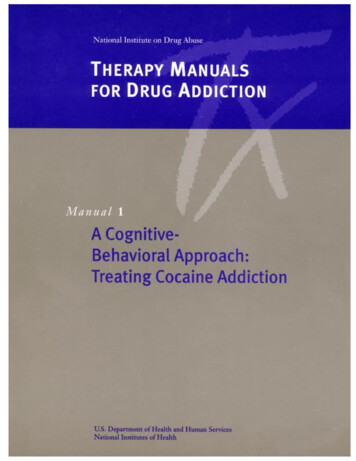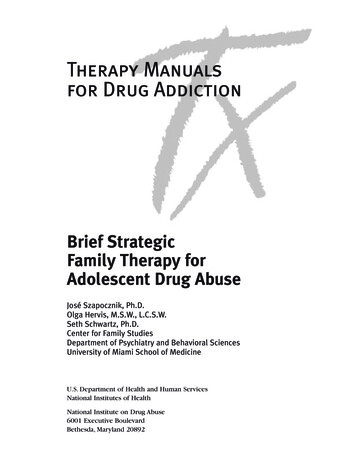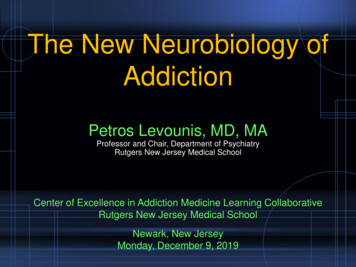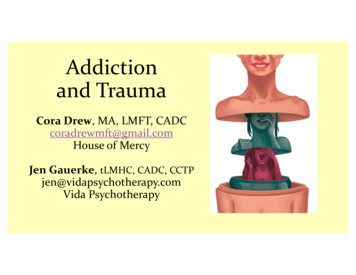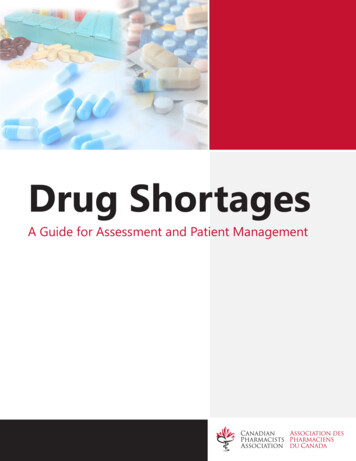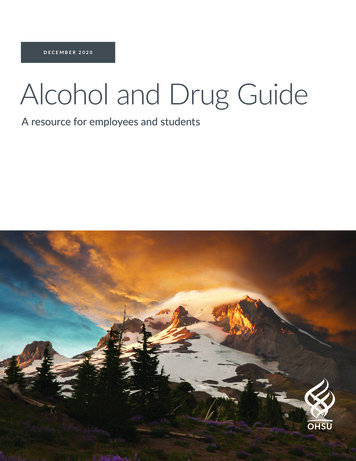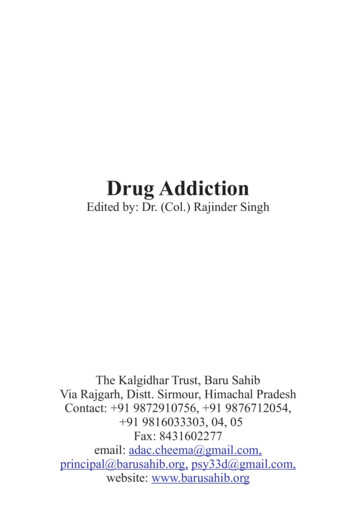
Transcription
Drug AddictionEdited by: Dr. (Col.) Rajinder SinghThe Kalgidhar Trust, Baru SahibVia Rajgarh, Distt. Sirmour, Himachal PradeshContact: 91 9872910756, 91 9876712054, 91 9816033303, 04, 05Fax: 8431602277email: adac.cheema@gmail.com,principal@barusahib.org, psy33d@gmail.com,website: www.barusahib.org
Publish in 2012Price: Rs.150/-
iINDEXSr. No.ArticlePage No.1.2.Introductionmu KbMDiiiv3.4.5.6.7.ForewordMessageDrug AbuseDrug Addiction in PunjabAlcoholism: Practitioner’sPerspectiveHerion/Smack AddictionRelapse in Drug AbusetreatmentCharacteristic of a substanceAbuser: Causative factors forDrug abuseIncorporating SpiritualConcept in AddictionMyths related to alcoholSpiritual Intelligence andAddictionPopular Misconception aboutMental disorderviiix12 - 2728 - 318.9.10.11.12.13.1432 - 4748 - 5960 - 6869 - 7778 - 8081 - 8485 - 9192 - 100
ii1521.Addiction to smoking Nicotinea Mental illness and DiseaseOpioid Addiction in PunjabVegetarianism: A radiantway to healthAddiction newly defined asChronic Brain DisorderPsychosocial Factors andDrug AbuseConquer Your Addiction:Gems of WisdompRPu ilq jIvn dw Gux hY Srwb147 - 148149 - 15522.nSy iek cuxOqI156 - 16723.nSIly pdwrQW dw syvn168 - 17224.niSAW dI mwr qy aus qoN1617.18.19.20.Cutkwrw25.101 - 109110 - 124125 - 133134 - 136137 - 146173 - 181mwnisk qxwE Aqy ies dwsmwDwn182 - 19226.qMbwkU syvn193 - 20627.gurmiq pRyrnw207 - 208
iiiIntroductionDrug addiction is a global phenomenon affecting everysphere of the society. Because of high prevalence in Punjab, it ishaving grave repercussion on the family and the individual. Thisbook on Drug Addiction contains articles contributed by thosehaving clinical expertise in dealing with cases of addictionadmitted in urban and rural De-addiction centres. The materialselected in these publications will be of interest and use to thepublic, social workers, counselors, psychologists, medicalstudents, family physicians and NGOs.Tobacco the 'gateway' drug and is highly addictivesubstance catches its victims at a very young age and soon afterthese young adolescents end up in poly addiction. No otheraffliction in the world is as fatal as is the tobacco. Theadolescence population needs to be aware of its deleteriouseffects.Misconceptions about liquor tend to perpetuate the useof alcohol. Ethanol is a toxic and addictive substance which isassociated with various adverse physical and neuropsychiatricdisorders. These persons are aversive to treatment and needtactful handling. Recovered addicts can play significant role ininspiring drug addicts and alcoholics to seek treatment.Opioids are one of the commonest of the addictivesubstances. India is country sandwiched between the two majoropioid producing zones i.e. golden crescent on the west andgolden triangle on the east. Earlier our country was involved inthe trafficking of opium and synthetic derivates as Heroin andsmack. Now it has become consumers of the illicit drugs notwithstanding the deterrent narcotic drug and psychoactivesubstances act.
ivMultiple factors may be involved which attract theyoung adolescent to drugs, such as desire for new experiment toseek joy and pleasure. Decadence of moral and religious values,the craze to be ultramodern coupled with boom in economy andunemployment are entraping the youth to drugs. Addiction andsociopathic personality frequently go hand in hand with eachother.Management of drug addiction and alcoholism shouldpreferably be holistic and involve of traditional treatment alongwith the concept emanating from spiritual intelligence. Most ofthe publications in this book reflect the experience gained by theauthors while working in the Red-Cross De-Addiction Centre,Mohali and another rural Akal De-Addiction Centre, Cheema,Distt. Sangrur. Many of these articles have appeared in reputedjournals, weeklies and dailies.I convey my sincere thanks to the contributors of thesearticles which would prove valuable in imparting basicinformation to all those who are involved in the care & treatmentof addicts.This work would not have been possible without theblessings of the visionary saint Baba Iqbal Singh Ji, President ofthe Kalgidhar Trust/Society, Baru Sahib - HP. I owe him mydeep sense of gratitude. I am indebted to Dr. Neelam Kaur,Advisor Health & Education and staff of the Kalgidhar Trust forextending help and support during compilation of this book.Dr. (Col) Rajinder SinghFormer Senior Advisor (Psychiatry)Armed ForcesIncharge, Akal De-Addiction CentreCheema & Jharon, Distt. Sangrur.
vmu KbMdivAwpk rUp iv c psrI niSAW dI mhwmwrI swfy dyS dIAWpRmu K smwijk Aqy ishq sm isAwvW iv coN ie k hY[ bIqy iqMn cwrdhwikAW dOrwn ies dy pRcln iv c BwrI auCwl AwieAw hY [ nvINpIVHI byhqwSw ies dldl iv c DsdI jw rhI hY [ icMqw dw ivSw hYik ies dI sB qoN v D mwr Xuvw vrg ƒ pY hrI hY [ hulwry mwxn dIcwh kwrn Aksr auh ieh vwdI shyV lYNdy hn, Aqy iPr iesckrivaU iv coN inklnw aunHW leI muSkl ho jWdw hY [ A DI ku sdIpihlW q k nSw-syvn smwj dy ie k Coty ijhy vrg q k hI sIimq sI[mn dIAW qwr-qrMgW nUM J t GVI leI rwgmeI bxwaux Aqy rMgInsupn AvsQw iv c ivcrx leI jW ijMdgI dIAW ql K hkIkqW qyqxwvW qoN mUMh moVn Kwqr kuJ QoVy ijhy lok hI niSAW dIAW BUlBul eIAW iv c gvwicAw krdy sn [ audoN vsoN dw ie k v fw vrg nSwsyvn nUM AYb mmJdw sI, Aqy ies qoN prhyj ie k gux smiJAW jWdwsI [ijauN ijauN jIvn dw rUp bdilAw, AwDuink jwpx dI cwhkwrn kdrW kImqW qy qOr qrIky bdly, rvwieqI smwijk qy DwrimkbMdSW kmzor pYNdIAW geIAW, rwjnIqI iBRSt huMdI geI, Srwb qyqMbwkU qoN pRwpq tYks dy lwlc ny hukmrwn nyqwvW nUM lok-ih qW v loNAMnHW kr id qw, niSAW dI lihr bwihr huMdI geI [ ienHW kwrnWkrky A j vsoN dw ie k v fw Bwg niSAW dI igRPq iv c hY [ koeIauqsukqw–vs, koeI PYSnybl qy AwDuink jwpx leI, koeI gm glqkrn leI Aqy koeI qxwau-pUrn, snyh-rihq nIrs jIvn iv c rMgBrn leI niSAW dI ijlHx iv c KuBdw jw irhw hY [
vigurUAW dI DrqI qy hsdw–vsdw pMjwb ies mMdBwgI siQqIqoN bwhrw nhIN, sgoN dUjy sUibAW nwloN ie k kdm A gy hI hY [ ie QySrwb, APIm Aqy ies dy ivk lpW (Bu kI, pRoksIvon, lomyitl, smYkAwid) dI AYifkSn bhuq Awm hY[ ipMfW iv c qMmwkU (zrdw, KYxI,gutKw Awid dy rUp iv c) c bx dI vwdI vI coKI pxp cu kI hY[fr g AYifkSn nSw-pRymI dy jIvn dw auh pVwA hY, jd auhmwnisk Aqy SrIrk rUp iv c nSy auqy inrBr ho jWdw hY[ audoN q knSy dI imkdwd (Dose) vI bhuq v D c ukI huMdI hY Aqy iesqoN pihlyvrgw srUr vI nhIN imldw[ nSw nw imly qW AmlI dy h f nhIN juVdyAqy SrIrk qy mwnisk qoVW aus nUM byhwl kr dyNdIAW hn[ ienHW qoNb cx leI ausnUM nSw syvn jwrI r Kxw pYNdw hY[ hux auh ie k mwniskrogI bx cu k huMdw hY[ ies siQqI qoN Awpxy Awp bwhr inklxw ausleI bhuq muSkl huMdw hY[ aus nUM lMby smyN q k mwhr Aqy suihrdmnocikqisk (Psychiatrist) duAwrw ielwj Aqy follow-up dI loVhuMdI hY[fw.(krnl) rwijMdr isMG duAwrw sMpwdq pusqk “fr gAYifkSn” ies ivSy qy ie k imAwrI rcnw hY Aqy krnl swihb AqyaunHW dy sihXogIAW dI klm dI dyx hY[ bhuigxqI krnl swihb dylyKW dI hY[ ies pusqk iv c fr g AYifkSn dI jitl sm isAw dyiviBMn pihlUAW nUM ivsqwr nwl ivcwirAw igAw hY[ ieh pusqkij Qy fIAYifkSn sYNtrW dy stwP dy mwrg-drSn leI v fmu lIgweIf swbq hovygI, au Qy Awm jnqw dI idlcspI dI Fyr swrIswm grI vI ies iv c mOjUd hY[ mYN AwsvMd hW ik ies qoN syD lY kyjnswDwrx niSAW qoN Awpxw dwmn bcw skygw Aqy nSw-pIiVqielwj duAwrw nSw iqAwgx dI pRyrnw gRihx krngy[ krnl swihbies igAwn–vrDk pusqk leI vDweI dy pwqr hn [
viikrnl rwijMdr isMG iksy jwx-pCwx dy mohqwj nhIN [ AwpcMfIgVH dy ie k au Gy mnocikqisk hn[ POj dI mulwzmq qoN irtwierhox auprMq Awp ny Awpxw jIvn smwj syvw nUM Aripq kr id qw hY [lgBg ie k dhwkw Awp rYf krws fIAYifkSn sYNtr muhwlI nwljuVy rhy hn, Aqy hux Akwl fIAYifkSn sYNtr, cImw swihb(sMgrUr) iv c ieh syvw inBw rhy hn [ Awp dI imhnq sdkw v fIigxqI iv c nSw-pIVqW ny ies koVH qoN injwq pweI hY [mwrc 2012fw. rwijMdr isMG1162, Pyz 9, mohwlIFormer Professor and Head of theDepartment of Social andPreventive MedicineDayand Medical CollegeLudhiana.
viiiFOREWORDAmong the greatest challenges being faced by nations ofthe world today is the evil habits that the youth takes to asdeveloping economies break off their shackles and the peoplesof these countries start enjoying the fruits of material gainsconsequent upon the economic uplift. The green revolution ofPunjab did precisely that. It gave easy money to the youth whowent berserk. Moral decadence and a debauched life style wereinevitable consequences as the Punjabi youth aped the West.Addiction to habit forming agents soon followed. One is notalarmed when one hears that per capita consumption of alcoholin Punjab is among the highest in the world. And worse still,more than 50% of young adult males are hooked to drugs.Amidst this dismal scenario we see islands of hope in the formof few schools like Akal Academies trying desperately to fightthis system, against all odds, by teaching and preaching valuesto the young children lest they go astray emulating their not soillustrious, elders. We also have few NGOs in the fray, who haveestablished facilities for counseling and de-addiction. But theseefforts are few and far between and lot still needs to be done totackle the alarming situation.The Akal De-addiction Centre at village Cheema inPunjab is one such effort. Over the years, the Centre has freedmore than 2500 patients from the clutches of these dreadfuladdictions. This compendium of very useful articles by Dr.(Col) Rajinder Singh, the Chief Psychiatrist and his colleaguesmanaging this Centre, is a timely and invaluable effort. Thesecollections pertain to the basic principles involved in dealing
ixwith this menacing problem, understanding the rural psychosocioeconomic dynamics that fuel this grave malady, possiblesolutions and management of patients afflicted with the disorderand finally of course- prevention.I am sure the book will be found useful not only bydoctors and staff handling these unfortunate patients, but alsoNGOs and other social activists and Government departmentsengaged in this work.May the Almighty bestow courage and strength to allwho are involved in this formidable task of protecting the youthand the society from the scourge of addiction to habit formingagents.Dr. Davinder SinghSecretaryThe Kalgidhar Trust/SocietyBaru Sahib
xMESSAGEDrug addiction is a phenomenon of overwhelmingimportance affecting every segment of the society; theindividual, the family and the community at a large. To startwith, the drug is taken for pleasure and later becomes a necessityto ward off the withdrawal features. It is a termite which couldendanger, spoil and finish any green tree, before it could bearfruits. It is a sweet poison for the human kind which has thepotential to devastate the usefully evolved socio- culturalcomplex network over the years.Drug abuse is a major public health problem that impactssociety on multiple levels. Drugs take a tremendous toll of oursociety, one third cases of cardiovascular diseases, cancers andHIV/AIDS are caused by drug abuse. By educating thecommunity and generating awareness about healthy lifestyle,we can prevent the single greatest cause of mortality andmorbidity in the world.Unfortunately, the most vulnerable and considerable partof our society i.e. adolescents and youths, in their highlycreative phase of life are the victim of this menace. Youth takedrugs for excitement and experimentation when they haveinadequate and misconceived notions about the drugs and theyget hooked to this disorder. Consequently, this pervasive diseaseshatters their motivation, goal, ethical and moral values of life.The book on drug addiction contains articles by authorshaving long experience of managing the addicts. The blending
xiof traditional treatment with spiritually evolved therapy is aunique approach of The Akal Deaddiction Centers run by TheKalgidhar Trust. Spiritual orientation fosters healthy cognition,positive vibrations which affect the person and the surroundingsThis book will prove to be of immense value tophysician, nursing, paramedical staff, social workers,counselor, psychologists and NGOs involved in themanagement of the addicts.May all those involved in the treatment of the Addictivedisorders be blessed with enthusiasm to rid the Addicts of theiraffliction, and reform these patients so that they can lead ahealthy family life and make the society wholesome.Dr. M.S. AtwalVice ChancellorETERNAL UNIVERSITYBARU SAHIB
DRUG ABUSEDr. (Col.) Rajinder SinghThe serious problem of Drug Addiction and Alcoholismis a global phenomenon of alarming proportions. It is erodingthe very existence of society. The scourge of drug dependencehas deleterious repercussions on the individual’s physical,emotional and socio-cultural spheres.The deaddiction of the drug dependent persons is a timeconsuming and a challenging job. It involves a radical change inthe lifestyle of the individual. The outcome depends on multiplefactors such as personality of the addict, associated emotionalproblems, nature of the drug, duration of abuse etc.IntroductionThe term Drug Addiction does not find mention in thepresent classification of diseases. However, the term addictionis being retained through the current prevalent use of the word“Deaddiction”. As per ICD 10 (International Classification ofDiseases 10th revision), the abuse of drug and alcohol is nowclassified under “Mental and behaviour disorder” due to use ofthe psychoactive substance. Diagnostic and statistical manualof mental disorder fourth edition (DSM - IV) classifies the sameunder “Substance related disorders”.More than 90% of the cases who report to theDeaddiction Centre indulge in opioid and alcohol abuse. Rest of“ When love is your greatest weakness, you will be the greatest person”Anon
13the cases of substance abuse pertain to cannabis,benzodiazepines, antihistamines and nicotine. Various types ofopioids used by the patient, the factors associated with onset ofabuse, modes of drug intake, reasons for seeking treatment andmanagement of the drug abuse are the topics which need theutmost attention of the family physicians.Drug TraffickingIt is fascinating to explore as to how and why anindividual starts taking intoxicating drugs. The various factscame to light while working in a “De-addiction Centre”sponsored by Ministry of Social Welfare, Government of Indiathrough the Punjab Red Cross Society. Most of the patients whoreport to the centre for treatment suffer from abuse of crude/pureopium or its synthetic derivatives. The next common categoryof patients who seek treatment at this “Drug De-addictionCentre” is the alcohol abuse category.Poppy is cultivated in various provinces such asRajasthan, Madhya Pradesh, Uttar Pradesh etc. Because oftrafficking, it is available in every nook and corner of thecountry. Most of the truck transport workers start using opiumderivatives and alcohol soon after joining this trade.The reason given by them is that they have to drive thevehicle during the night and an optimum use of opium or itsderivatives keep them awake and alert. Moreover, manytransport owners give incentives to workers who complete theirjourney in stipulated time. Abuse of opium and alcohol as wellas the incentive for high speed and fast driving are thepredominant factors responsible for high rate of vehicularaccidents. At the same time, truck drivers play an important rolein procuring and distribution of illicit drugs.
14Truck Driver’s SubcultureAny truck driver who takes opium and liquor also takestabacco either in chewable form or by smoking. Taking ofopium and tobacco by the truck transport workers during theprolonged and tiresome driving and to gulp down a quarter of abottle or more to induce sleep may be termed as a part of TruckDrivers Subculture. When asked as to why do the trucktransport workers indulge in intoxicants, their prompt reply was“who would not resort to drugs under such adverse anduncongenial circumstances”. A truck driver who does not usepsychoactive drugs is an exception.ClassificationClassification of psycho-active drugs (substance abuse)as per ICD 10, is as atives and hypnotics?Benzodiazepines?BarbituratesCocaineOther o?Cigarettes?Chewing tobacco?Snuff?Pipes and cigars
159. Volatile solvents?Gasoline?Glue etc.Abuse Of OpioidsDrugs can entrap any member of the society, withoutconsideration of status, education, caste or creed. A commoncategory of people who abuse opium is an uneducated personfrom a rural background coming from lower rungs of societye.g. a farm labourer who allegedly starts taking opium underpeer pressure to raise the work output and to counter the fatigueof strenuous labour. On many occasions, it is the agriculturefarm owner who induces a labourer to take opium for his selfishmotives.Opium SubstitutesWhen an individual is not able to procure opium forhimself, he resorts to other substitutes which are as follows:1. Bhuki (crushed dodas)2. Tablet codeine phosphate3. Tablet Ethyl morphine hydrochloride4. Dextropropoxyphene hydrochloride5. Diphenoxylate hydrochlaride.6. Certain cough syrups containing codeine phosphate.Brown Sugar AddictionBrown sugar is a spurious and cheaper form of Heroin.Smack (Brown Sugar) diacetyl Morphine or synthetic narcoticis a very potent and highly addictive substance used by adultshailing from urban background. Smack is usually used in twoways. A common practice known as “chasing” where the userinhales the smoke of heated ball of brown sugar. The smack is
16heated meticulously over an aluminium foil paper and theindividual follows this moving ball with the pipe in his mouthfor inhaling the smoke. Puffs of cigarettes are smoked by thesmack chaser as the sips of liquor are followed by snacks.The other common method of use of smack is bysniffing. Rarely, ‘smack’ may be taken by intravenous injectionor is mixed with cigarettes and smoked. The smack addict referto the ‘number of lines’ produced by the moving ball of brownsugar (on the aluminum foil paper) to convey the quantum ofbrown sugar chased by him.Factors Associated With Opioid Abuse:Thrill And ExcitementSome of the patients attribute the onset of drug intake toget a thrill or to fulfill the curiosity about the drug. The firstexperience is perceived as exciting and pleasant. Repeatedabuse leads to tolerance and subsequent increase in the dosage.Others have a wish to conform to the norms of the peer group.This peer group who is experimenting with various drugs,generates a similar desire in the persons who succumb to theprevailing pressure. They have difficulty in asserting their viewpoint and the new entrants act in a way approved by the peergroup. The thrill of new, exciting and novel experience is thefirst step towards a very long journey of drug devastation.Domestic stress arising out of the strained interpersonalrelations amongst the members of the family, financialstringency and adjustment problems may contribute to the drugabuse either by precipitating the onset or by perpetuating the useof drug.
17Physiological Actions Of OpioidsThe opioids (opium and synthetic narcotic drugs) causeno alerting or awakening response in the human beings. On thecontrary, the opioids cause sluggishness and induce sleep andproduce a sensation of relaxation. It is the feeling of tranquilityand euphoria caused by opioids which pulls the truck driversand a strenuous laborers through the stress of continuous nightdriving and hard labour which is allegedly interpreted asalerting and increased output of work. Infact, opioids have aravaging effect on the work output and efficiency of anindividual. He has to waste his time in procurement of the illicitdrug and incessant preoccupation with the arrangement of hisfinancial resources for future supply of the drug.The complex of pleasant feeling, tranquility anddecreased concern about anticipated problem after ingestion ofopioids is often referred to as ‘high’. When synthetic opioids areself-administered intravenously or sometimes when brownsugar is smoked, there is a sharp increase in the level of the brainopioids, that produces a distinct, intense and a generallypleasurable sensation, often referred to by these heroin andsmack addicts as ‘flash’ or ‘rush’. Some users liken the feelingto sexual orgasm. Such ‘rush’ is not experienced with a slowonset of opioid action through oral or subcutaneous routes.These experiences may reinforce the use of opioids despite therisks.Adolescence - A Period Of RevoltIt is not uncommon to encounter an adolescentmanifesting his hostility against his family members especiallythe father by resorting to drugs. Adolescence is a period ofprotest against the conventional norms and established values of
18life. Lack of communication between the son and the father andthe maternal overprotection fosters emotional problem in theoffspring which may ultimately be manifested by drug abuse.Use Of Pain Relieving DrugsMajority of the patients who are given pain relievingdrugs during a physical illness do not develop drug addiction.The indiscriminate use of narcotic analgesics by the treatingphysicians and quacks can induce a vulnerable person into drugabuse. Patients suffering from chronic pain due to traumaticinjuries, backache, police tortures and using narcotic analgesicslend to become addicted to opioids.Learning TheoryConditioning factors may play a part in the causation ofaddiction. Feelings of tranquility and peace after intake ofopium narcotic and the relief of the discomfort experiencedthereafter reinforce the individual to continue the use of narcoticdrugs.The basis of this learning theory is the Pavlovianconditioned response. Experience of ‘high’ and ‘rush’ afterintake of opioids encourages the person to repeat the rewardingresponse. There may be interplay of many more factors whichmake an individual dependant on narcotic drugs.If some elder member of the family is addicted to drug,the growing child tends to shape his behavior with the model ofelders. The aspect of behavior which arouses pleasure is easilyadapted by the child.Accessibility Of Drug AndPersonality FactorsEasy availability of the drug may be associated with
19addictive behavior as may be seen amongst professional peoplehandling the drug e.g. doctors, nurses, registered medicalpractitioners, chemists, druggists etc. Many a times, theaddiction of the drugs may be symptom of some deep rootedpersonality disorder in a emotionally immature personality.Arrogant behavior, indifferent attitude towards others, wish forimmediate gratification of one’s desires and tendency to cheatand lie, all these point to a psychopathic personality disorder.Biological ExplanationsIt has been found that human brain produces endogenousmorphine and codeine. Opiates are secreted in excess when aperson is physically hurt and it accounts for the absence of painduring the acute state of traumatic injury. From the biologicalview point, it is postulated that some persons may be deficient inthese endogenously opiate producing site. And this may be thereason for them to resort to external supply of opioids. Becauseof the development of tolerance, these individuals become drugdependent.Role Of EthicsLoosening of the grip on moral and ethical values,especially during the adolescent period, predispose theindividual to drugs. Recent times have witnessed rise ofintolerance, aggression and violent behavior at all levels i.e.social, family and individual. The unethical behavior anddegradation of moral values are closely linked with the abuse ofdrugs.Buperinorphine AddictionAnother hard drug to which the youth gets addicted isBuperinorphine (Injection Tidigesic/ Norphin). In the company
20of other drug dependent persons, the first ‘shot’ is usually givenby someone else intravenously after which a sense ofexhilaration and thrill is experienced soon after the injection.Normally, Inj. Buperinorphine is not taken alone. Other drugswhich are combined along with it are:a)b)c)d)Inj. Pherniramine maleateInj. PromethazineInj. DiazepamInj. Pentazocine lactateThese drugs enhance the feeling of elation whichprompts the abuser to repeat the experience.Those who use Buprenorphine, their legs and arms areswollen due to blockage of the blood flow because of theinflammation of the veins. Their limbs may be covered withmultiple scars due to the ulcers caused by unsterilized andunhygienic syringes used at wrong sites for injecting the drugintravenously. If the same syringe is used, there is possibility oftransmitting HIV/Hepatitis B & C from one addict to another.Because of easy availability of Norphin Injection anddifficulty in procuring ‘smack’, many smack users shift toNorphin. Such persons abusing smack can be identified by thepresence of burn scars on the tips of the fingers and thumbcaused by ‘chasing’ smack during the ‘trip’. Norphin abuse ismore frequently encountered than the ‘smack’ abuse.De -addictionDe-addiction of the drug dependent person is a very timeconsuming and a challenging job. The individual is got rid of thedrug and properly rehabilitated only when the chances ofreverting to the drug are minimum. It involves a radical changein the lifestyle of the individual. The outcome of the de-
21addiction depends on the personality of the addict, associatedemotional problems, nature of the drug and duration of abuse.Hard drug addicts (of ‘Smack’, ‘Heroin’, Inj Norphin’, InjMorphine) tend to have high rate of recurrence and relapses.Seeking TreatmentThe drug abuser gives various reasons for seekingtreatment. There is partial realization that his addictive behavioris causing disruption in the family. Frequent quarrels andskirmishes at home make him feel upset. He realizes that he isnot good model for his growing children and he has followed adeviant path.Financial stringency is another reason put forward. Thedrugs have drained the monetary resources and there is drasticdip in the socioeconomic status. Yet, the addicts maintain ahierarchy in their social standing.Lowering of the social esteem due to the stigmaassociated with drug abuse and poor prospect of finding asuitable marriage proposal for his children, can drive him toseek abstinence from drugs. One of the patients reported that theannoyance shown to his addictive behavior by his young sonaged 4 years was the reason for him to come to the De-addictioncentre for treatment. With passage of time, the person tends tobecome responsible and mature and hence desires to get rid ofdrug seeking behavior.Yet another reason given by the opium dependent personis that he is not able to perform any social obligation in thefamily because of the fear that his addictive behavior willbecome widely known to the relatives. This may havepsychological repercussions on his social esteem.
22Sometimes, the ill effect on the health of an addictedperson may invoke him to seek treatment to get rid of the drugwhich damaged the body organs. This is especially applicable inthe case of alcohol which causes liver disease, gastriculceration, inflammation of the pancreas, polyneuritis,psychiatric illnesses, epilepsy, dementia etc. On the contrary,the narcotic addicts do not appear to be having grave physicalproblems as that of alcohol abuse.ManagementThe treatment of drug addiction may be consideredunder the following heads:1. Pre-hospital PhaseMany of the drug abusers have inadequate motivation toget rid of it. In spite of the devastation caused by the drug, thepatient shows no inclination to get treatment. Thetherapist/counsellor’s job is to solicit cooperation of the patientto seek medical advice. Free and frank discussion may lay baremisconceived notions nurtured by the patient which maydirectly or indirectly prevent him to seek treatment. Motivationof an individual with a drug problem is a vital factor whichdetermines the ultimate outcome of the care. No useful purposeis served in forcing a patient for admission, if he does not desireto be helped and treated.II DetoxificationIt is the management of withdrawal symptoms. Due todevelopment of tolerance, greater quantity of the drug isrequired to produce the same effect. Patients have been treatedfor opium addiction who were consuming more than 20 gm aday and smack, more than 2 gm/day in this De-addiction
23Centre. Sudden withdrawal of the drug is very distressing andpainful. Patient may complain of aches and pains especially ofthe calf muscles, watering of the eyes, running of the nose, hairraising on the body, sweating or feeling of numbness in thelimbs, disturbed sleep, poor appetite, restlessness etc. Thesesymptoms are managed by drugs such as methadone, clonidinefor symptomatic relief. During the detoxification, it is ensuredthat the patient gets proper sleep and rest. At our Centre,buprenorphine which blocks the opioid induced euphorea isused as an agent for detoxification.Cold TurkeyCold Turkey method of treatment consists of suddenwithdrawal of the drug without administrating any medicine.The patient is encouraged to bear the pain and suffering of thewithdrawal. It is postulated that the agony of the patient acts as adeterrent for the addictive person and it is likely that he mayabstain from the drug. This form of treatment is followed as amatter of policy in Singapore.AcupunctureAcupuncture is also one of the methods of treatment. Theskin punctures may cause the endogenous opiate to be secretedin the body and hence the severity of the withdrawal feature maybe reduced considerably.III. RehabilitationThe individual is put on a long-term methadone therapyfor maintenance purposes. Patient is relieved of the incessantpreoccupation with the procurement of the drug and hence canhelp him to be occupied with some constructive employment.Methadone is not available in India. It is pertinent to mention
24that till recently opium was being supplied to the addicts by thePunjab Health Department. Similarly, methadone is suppliednow in western countries. The disadvantage with methadone oropium supply is that the patient continues to use the nar
5. Drug Abuse 12 - 27 6. Drug Addiction in Punjab 28 - 31 7. Alcoholism: Practitioner's Perspective 32 - 47 8. Herion/Smack Addiction 48 - 59 9. Relapse in Drug Abuse treatment 60 - 68 10. Characteristic of a substance Abuser: Causative factors for Drug abuse 69 - 77 11. Incorporating Spiritual Concept in Addiction 78 - 80 12.

